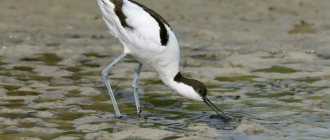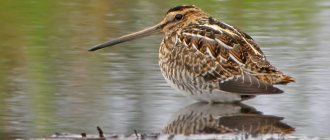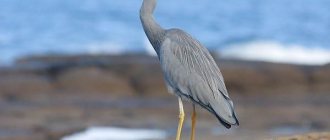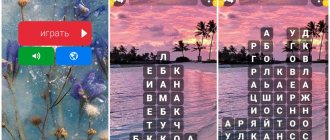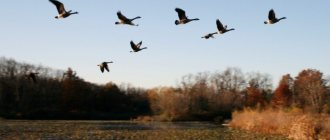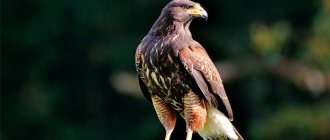| Snipe | ||
| ||
| Scientific classification | ||
| intermediate ranks Domain: | Eukaryotes | |
| Kingdom: | Animals |
| Sub-kingdom: | Eumetazoans |
| Without rank: | Bilaterally symmetrical |
| Without rank: | Deuterostomes |
| Type: | Chordata |
| Subtype: | Vertebrates |
| Infratype: | Ghostostomes |
| Superclass: | Quadrupeds |
| Class: | Birds |
| Subclass: | New palates |
| Squad: | Charadriiformes |
| Suborder: | Scolopaci Stejneger, 1885 |
| Family: | Snipe |
Snipe
(lat.
Scolopacidae
) is a branched family of birds from the order
Charadriiformes
.
Description
Representatives of snipes live on coasts and in humid biotopes. Only a few species are adapted to dry areas. A characteristic feature of snipes is their rather long legs and long beak, with which they search for prey in mud and coastal pebbles[1]. Snipe food includes worms, mollusks, crustaceans, small fish, insects and their larvae[2], as well as partly food of plant origin.
Many species nest in open areas, occurring in northern Europe and Siberia. In other parts of Europe, they can only be seen during migration, when they stop in large flocks at bodies of water. Most species lay eggs in small depressions in the ground, where they are well camouflaged due to their spotted coloring. The hatched chicks leave the nest very quickly [3] and begin to look for food on their own, although they remain under the supervision and continue to be warmed by one of the parents. Many species of snipe winter in Africa, some also in southern Europe and Asia. Sometimes their migratory achievements are remarkable, for example in the Icelandic sandpiper ( Calidris canutus
). Sometimes they fly at night, making characteristic sounds.
Links[ | ]
- Snipe // Encyclopedic Dictionary of Brockhaus and Efron: in 86 volumes (82 volumes and 4 additional ones). - St. Petersburg, 1890-1907.
| Dictionaries and encyclopedias |
|
| Taxonomy |
|
| In bibliographic catalogs |
|
Notes
- Piersma Theunis.
Handbook of the Birds of the World. Volume 3, Hoatzin to Auks. - Lynx Editions, 1996. - P. 444–487. — ISBN 84-87334-20-2. - Estrella, Sora; Masero, José A. (2007). "The use of distal rhynchokinesis by birds feeding in water." Journal of Experimental Biology 210
(21):3757–3762. DOI:10.1242/jeb.007690. - Harrison, Colin JO
Encyclopaedia of Animals: Birds / Forshaw, Joseph. - London: Merehurst Press, 1991. - P. 103–105. — ISBN 1-85391-186-0. - Thomas, Gavin H.; Wills, Matthew A.; Székely, Tamás (2004). "A supertree approach to shorebird phylogeny". BMC Evol. Biol. 4
. DOI:10.1186/1471-2148-4-28. PMID 15329156. - Vinokurov A. A.
Rare and endangered animals. Birds / edited by Academician V. E. Sokolov. - M.: "Higher School", 1992. - P. 446. - 100,000 copies. — ISBN 5-06-002116-5. - [www.xeno-canto.org/species/Limnodromus-griseus Short-billed Godwit Limnodromus griseus]
- [www.balatsky.ru/AVES/Koblik,Arkhipov_2014.pdf E. A. Koblik, V. Yu. Arkhipov.
Bird fauna of the countries of Northern Eurasia within the borders of the former USSR. Lists of species. M.: KMK, 2014. 173 p.] - Koblik E. A., Redkin Ya. A., Arkhipov V. Yu.
List of birds of the Russian Federation. - M.: Partnership of Scientific Publications KMK, 2006. - P. 92. - 256 p. — ISBN 5-87317-263-3 - [www.xeno-canto.org/species/Limnodromus-scolopaceus American Snipe Limnodromus scolopaceus]
Classification[ | ]
The family includes the following taxa[5][6]:
- Woodcock ( Scolopax
) Woodcock (
S. rusticola
) - Amami woodcock ( S. mira
) - New Guinea woodcock ( S. rosenbergii
) - Malayan woodcock ( S. saturata
) - Celebes woodcock ( S. celebensis
) - Bukidnon woodcock ( S. bukidnonensis
) - Moluccan woodcock ( S. rochussenii
) - American woodcock ( S. minor
)
)
- Chetham Island woodcock ( C. pusilla
)
)
)
- Garnish ( L. minimus
)
)
- Mountain snipe ( G. solitaria
)
)
)
)
)
)
)
)
)
)
)
)
)
)
)
)
)
)
- Short-billed snipe[7] ( L. griseus
)
)
)
)
- Great godwit ( L. limosa
)
)
)
)
)
- Little curlew ( N. minutus
)
), probably extinct
)
)
)
)
)
)
)
- Bartramia, Long-tailed Sandpiper ( B. longicauda
)
)
- Goldfinch ( T. erythropus
)
)
)
)
)
)
)
)
)
)
)
)
- Morodunka ( X. cinereus
)
)
- Carrier ( A. hypoleucos
)
)
)
- Ashy snail ( H. brevipes
)
)
)
- Hymenoplastus ( C. semipalmatus
)
- Southern snail ( Prosobonia parvirostris
)[11]
)
)
- Turnstone ( A. interpres
)
)
)
- Sandpiper ( Aphriza virgata
)
)
- Greater sandpiper ( C. tenuirostris
)
)
)
)
)
)
)
)
)
)
)
)
)
)
)
)
)
)
)
)
- Spoontail ( E. pygmeus
)
)
- Mudweed ( L. falcinellus
)
)
- Canadian sandpiper ( T. subruficollis
)
)
- Turukhtan ( P. pugnax
)
)
- Greater phalarope ( S. tricolor
)
)
- Round-nose phalarope ( P. lobatus
)
)
An excerpt characterizing the Bekasovs
Several captured officers, in order to get a better view, climbed onto the wall of the burnt house near which Pierre stood. - To the people! Eka people!.. And they piled on the guns! Look: furs... - they said. “Look, you bastards, they robbed me... It’s behind him, on a cart... After all, this is from an icon, by God!.. These must be Germans.” And our man, by God!.. Oh, scoundrels!.. Look, he’s loaded down, he’s walking with force! Here they come, the droshky - and they captured it!.. See, he sat down on the chests. Fathers!.. We got into a fight!.. - So hit him in the face, in the face! You won't be able to wait until evening. Look, look... and this is probably Napoleon himself. You see, what horses! in monograms with a crown. This is a folding house. He dropped the bag and can't see it. They fought again... A woman with a child, and not bad at all. Yes, of course, they will let you through... Look, there is no end. Russian girls, by God, girls! They are so comfortable in the strollers! Again, a wave of general curiosity, as near the church in Khamovniki, pushed all the prisoners towards the road, and Pierre, thanks to his height, saw over the heads of others what had so attracted the curiosity of the prisoners. In three strollers, mixed between the charging boxes, women rode, sitting closely on top of each other, dressed up, in bright colors, rouged, shouting something in squeaky voices. From the moment Pierre became aware of the appearance of a mysterious force, nothing seemed strange or scary to him: not the corpse smeared with soot for fun, not these women hurrying somewhere, not the conflagrations of Moscow. Everything that Pierre now saw made almost no impression on him - as if his soul, preparing for a difficult struggle, refused to accept impressions that could weaken it. The train of women has passed. Behind him were again carts, soldiers, wagons, soldiers, decks, carriages, soldiers, boxes, soldiers, and occasionally women. Pierre did not see people separately, but saw them moving. All these people and horses seemed to be being chased by some invisible force. All of them, during the hour during which Pierre observed them, emerged from different streets with the same desire to pass quickly; All of them equally, when confronted with others, began to get angry and fight; white teeth were bared, eyebrows frowned, the same curses were thrown around, and on all faces there was the same youthfully determined and cruelly cold expression, which struck Pierre in the morning at the sound of a drum on the corporal’s face. Just before evening, the guard commander gathered his team and, shouting and arguing, squeezed into the convoys, and the prisoners, surrounded on all sides, went out onto the Kaluga road. They walked very quickly, without resting, and stopped only when the sun began to set. The convoys moved one on top of the other, and people began to prepare for the night. Everyone seemed angry and unhappy. For a long time, curses, angry screams and fights were heard from different sides. The carriage driving behind the guards approached the guards' carriage and pierced it with its drawbar. Several soldiers from different directions ran towards the cart; some hit the heads of the horses harnessed to the carriage, turning them over, others fought among themselves, and Pierre saw that one German was seriously wounded in the head with a cleaver. It seemed that all these people were now experiencing, when they stopped in the middle of a field in the cold twilight of an autumn evening, the same feeling of an unpleasant awakening from the haste that gripped everyone as they left and the rapid movement somewhere. Having stopped, everyone seemed to understand that it was still unknown where they were going, and that this movement would be a lot of hard and difficult things. The prisoners at this halt were treated even worse by the guards than during the march. At this halt, for the first time, the meat food of the prisoners was given out as horse meat. From the officers to the last soldier, it was noticeable in everyone what seemed like a personal bitterness against each of the prisoners, which had so unexpectedly replaced previously friendly relations. This anger intensified even more when, when counting the prisoners, it turned out that during the bustle, leaving Moscow, one Russian soldier, pretending to be sick from the stomach, fled. Pierre saw how a Frenchman beat a Russian soldier for moving far from the road, and heard how the captain, his friend, reprimanded the non-commissioned officer for the escape of the Russian soldier and threatened him with justice. In response to the non-commissioned officer's excuse that the soldier was sick and could not walk, the officer said that he had been ordered to shoot those who lag behind. Pierre felt that the fatal force that had crushed him during his execution and which had been invisible during his captivity had now again taken possession of his existence. He was scared; but he felt how, as the fatal force made efforts to crush him, a life force independent of it grew and strengthened in his soul. Pierre dined on a soup made from rye flour with horse meat and talked with his comrades. Neither Pierre nor any of his comrades talked about what they saw in Moscow, nor about the rudeness of the French, nor about the order to shoot that was announced to them: everyone was, as if in rebuff to the worsening situation, especially animated and cheerful . They talked about personal memories, about funny scenes seen during the campaign, and hushed up conversations about the present situation. The sun has long since set. Bright stars lit up here and there in the sky; The red, fire-like glow of the rising full moon spread across the edge of the sky, and a huge red ball swayed amazingly in the grayish haze. It was getting light. The evening was already over, but the night had not yet begun. Pierre got up from his new comrades and walked between the fires to the other side of the road, where, he was told, the captured soldiers were standing. He wanted to talk to them. On the road, a French guard stopped him and ordered him to turn back. Pierre returned, but not to the fire, to his comrades, but to the unharnessed cart, which had no one. He crossed his legs and lowered his head, sat down on the cold ground near the wheel of the cart and sat motionless for a long time, thinking. More than an hour passed. Nobody bothered Pierre. Suddenly he laughed his fat, good-natured laugh so loudly that people from different directions looked back in surprise at this strange, obviously lonely laugh. - Ha, ha, ha! – Pierre laughed. And he said out loud to himself: “The soldier didn’t let me in.” They caught me, they locked me up. They are holding me captive. Who me? Me! Me - my immortal soul! Ha, ha, ha!.. Ha, ha, ha!.. - he laughed with tears welling up in his eyes. Some man stood up and came up to see what this strange big man was laughing about. Pierre stopped laughing, stood up, moved away from the curious man and looked around him. Previously loudly noisy with the crackling of fires and the chatter of people, the huge, endless bivouac fell silent; the red lights of the fires went out and turned pale. A full moon stood high in the bright sky. Forests and fields, previously invisible outside the camp, now opened up in the distance. And even further away from these forests and fields one could see a bright, wavering, endless distance calling into itself. Pierre looked into the sky, into the depths of the receding, playing stars. “And all this is mine, and all this is in me, and all this is me! - thought Pierre. “And they caught all this and put it in a booth fenced off with boards!” He smiled and went to bed with his comrades.
